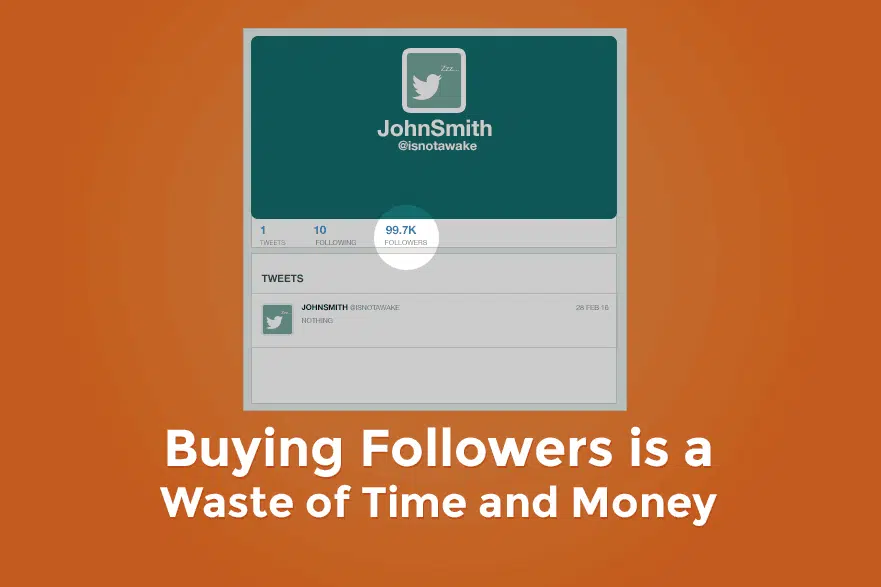

Today, it’s pretty common to measure digital authority in followers and likes. When you see an account with 100,000 followers on Twitter, you assume they’re doing something right.
In reality, this isn’t the case anymore, buying twitter followers doesn’t work. Sure, having few or no followers doesn’t help you, but having thousands of irrelevant followers doesn’t help you, either.
FOLLOWERS VS. ENGAGEMENT
If you’re curious to see how successful an account actually is, check for engagement. How many retweets, likes, and comments does the account earn? Maybe 25%? 10%? Even fewer?
Engagement should be around 10% of social interactions based on the number of followers you have. That means if you have 100 followers, you should earn roughly10 legitimate likes, retweets, or comments on your post. This is an optimal ratio for smaller and medium-sized accounts. Larger accounts (10,000+ followers, Likes, etc.) are more likely to have “zombie” followers that don’t engage with content at all, so the ratio drops to 2-5%. Regardless—the bigger the percentile, the more influential the account.
Another metric to check is how many users that account is following. A company’s account shouldn’t be following every single account that follows them—and should pay attention to avoid spam accounts. Why? Because this drives down your engagement percentage, and your engagement is the true test of your digital authority.
DO I HAVE FAKE FOLLOWERS?
Some agencies buy followers as a way of boosting a client’s social media account.
This is an embarrassing practice that only helps the people who sell fake followers to inept, lazy, or otherwise ignorant people.
So how can you check to see if you have fake accounts following your real one?
The Fake Follower Checklist
1) Check for profile pictures. If the account is missing a profile picture, that’s a red flag and probably means that the account was quickly set up for one purpose—to follow people for pay.
2) Check the bio section. An empty bio is the same issue as the missing profile photo: the account was quickly created.
3) Check how many tweets the account has. If the account rarely posts and doesn’t interact with other accounts, the account is probably fake.
4) Check the account’s location and language. Foreign accounts with zero relevance to your industry are probably fake accounts.
5) Check to see who else that account is following. If the account has almost no followers, but is following a lot of similar accounts to yours (e.g. small businesses), that’s a red flag.
That being said, if you have a new follower who happens to be a Croatian teenager, it’s probably no big deal. However, if you have hundreds (or even thousands) of followers who meet more than one of the criteria seen above, they’re most likely fake followers, and won’t provide any real value to your social media endeavours.
WHAT CAN I DO ABOUT IT?
For a business account, the best thing you can do is to stop working with agencies that buy followers. If that agency isn’t doing social media properly, who knows what else they’re cutting corners on?
If you’re worried that someone will find out and call you out on having fake followers, you can either block all the fake accounts, one by one, or you can start a new account. That may be a bit drastic, but if your reputation is on the line, it’s not a terrible idea to start fresh.
BE INTERESTING ONLINE
Obviously, right? You might hear it all the time, but businesses that are actually interesting online will earn followers and engagement organically. Posting good content shows you’re a leader, and you have something valuable to say. This is what separates social media industry leaders from everyone else.
Also, post often. Offer news, images, information, and anything else that engages people. Interact with them, too. Say something nice to a stranger, or share something interesting with your friends. Reach out, and people will reach back.
ONE LAST THING…
Twitter frequently purges fake accounts, so if you are considering a quick and dirty jumpstart for your new Twitter account, do so at your own risk.
Source: Hello BLOG
Recent Articles
Write For Us
Think you’ve got a fresh perspective that will challenge our readers to become better marketers? We’re always looking for authors who can deliver quality articles and blog posts. Hundreds of your peers will read your work, and you will level up in the process.Ready to grow? Say Hello









